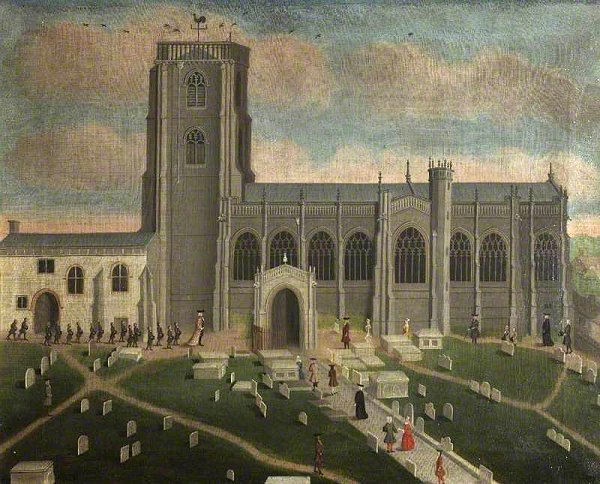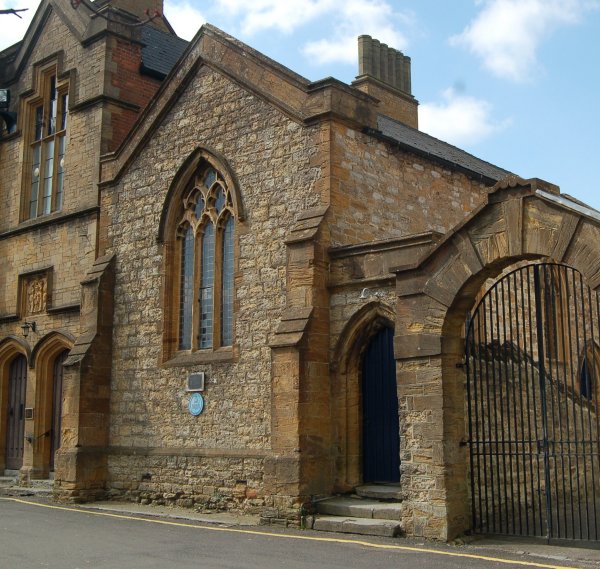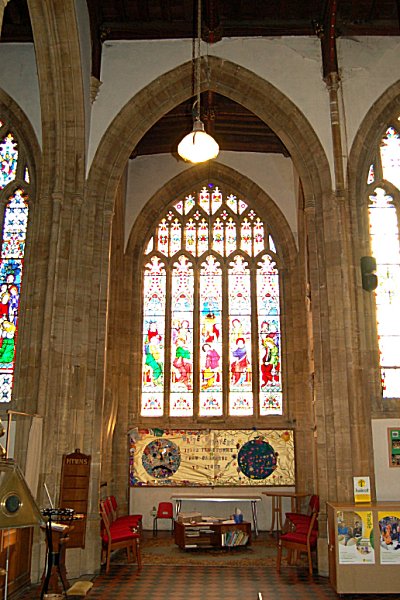chantries of St John's church
chantry of the blessed virgin mary
Of the Church of St John the Baptist
As early as 1302 the Woborn Muniments record various properties in the town belonging to the Chantry of the Blessed Virgin Mary. In 1392, during the reign of Richard II, Alice Gryse gave a messuage to William Montford, Provost of Yeovil, and to his successors, on condition that a payment was made to "the chaplain of the chapel of St Mary" and further stating that thirty years before, a similar by John Hopkins was made to William Jamys, the then Provost, on condition that an annual payment of four shillings was made to the chaplain.
John Belman (also written as Bellman and Bullman) appears as the perpetual chaplain of the 'Chantry of Our Lady' in certificates in the Bishop's Register between 1450 and 1467.
The first time that two separate chantries dedicated to the Virgin Mary are noted was in 1450 when indulgences granted by the Bishop for those contributing to the relief of those who had suffered by the recent great fire in Yeovil and towards rebuilding property belonging to chantries and the almshouse makes reference to "11 belonging to the chantry of the Virgin Mary outside the church" and "19 belonging to another chantry of the Virgin Mary in the said church."
The two chantries dedicated to the Virgin Mary went by several names, including Our Lady, the Blessed Virgin Mary, and so forth. One was 'within' the church and the other 'without' and were frequently referred in full as the 'Chantry Chapel of the Blessed Virgin Mary within/without the Church'.
The Chantry of the Blessed Virgin Mary 'within' the church was originally a chapel in the south transept of St John's church. It was transferred here from the earlier church where it had been in existence certainly from 1302. It was then possibly a separate building attached to the tower of St John's church (see Gallery). This chapel was converted into a school-house in 1573 and was used as a Charity Grammar School for boys as seen below. The chantry chapel was taken down and rebuilt in 1855 in its present position opposite the west door of St John's and is today known simply as The Chantry.
The Chantry of the Blessed Virgin Mary 'without' the church was originally a building in Quedam Street (later Vicarage Street), probably in the 1400s. An Indenture of 1790 in my collection, for the sale of land known as 'the Chantry' states "a quarter of an acre (more or less) with an Old Stable thereon situate within the Borough of Yeovil aforesaid called or known by the name of the Chantry bounded on the South by a street called Vicarage Street and on the North by the back of the Almshouse." I would assume that by the time of the 1790 indenture, the Chantry building had either collapsed or been demolished and that the 'old stable' backing on to the Almshouse was the only building remaining at that time. (see Map)
Many chantries acquired great wealth over the years as ever more benefactors made bequests in return for prayers for their souls. In 1548 the Return of Chantries listed the wealth of the Chantry of the Virgin Mary within the church as follows "The Chauntrie or oure lady founded within the same churche; Yearly worth, lands, tenements and hereditaments in the tenure of sundry persons.... by the rental of the same £12 11s 2d (about £6,400 per annum at today's value) Plate and ornaments - A chalice of silver gilt weighing 15oz. Ornaments appraised at 26s 4d" (about £700 at today's value).
MAP - The Chantry of the Virgin mary 'without' the church

Edward Bullock Watts' 1806 map of Yeovil showing the junction of Sheep Lane / Court Ash / Reckleford / Silver Street (today's North Lane / Court Ash / Market Street / Silver Street). At centre, is the original Pall Tavern (before it was rebuilt in 1836) with a narrow alley running alongside leading to the original (and slightly bent on plan) Woborn Almshouse that also faces Miller's Well at its northern end.
The indenture describes the land in question as "a quarter of an acre (more or less) with an Old Stable thereon situate within the Borough of Yeovil aforesaid called or known by the name of the Chantry bounded on the South by a street called Vicarage Street and on the North by the back of the Almshouse." This would have been the location of The Chantry of the Virgin Mary 'without' the church.
The indenture probably describes the area entered from above the "ag" of Vicarage on the map. The grey building would be the 'old stable' (dwellings were shown in red) and this does back onto the rear of the Woborn Almshouse.
Survey of the Chantry & its benefactors, 1548
The following is taken from the Survey and Rental of Somerset Chantries of 1548. Note that I have converted amounts from Latin to English, for example xiiijli xjs ijd as £14 11s 2d.
The
Chantry of the
blessed Mary the
virgin within
the parish
church there.
..... holds the
dwelling house
of the said
Chantry and
renders per ann.
3s.
Hugh Cogen holds a tenement, and a cottage with a garden there, and renders per ann. 3s.
The same holds a garden in Southstrete with a virgate (about 20 acres) of meadow and 3 virgates of arable land, and renders per ann. 2s 8d.
William Hayne holds a burgage with a garden, and renders per ann. 6s 8d.
William Slape holds a tenement with a garden and 3 acres and a half of arable land, and renders per ann. 20s.
The same holds a barn and a garden in Quedam strete, and renders per ann. 5s.
Philip Cromell holds a burgage with a garden lying in Grope Lane, and renders per ann. 6s.
John Parker holds a burgage in South strete with a garden and 3 acres and a half of arable land, and renders per ann. 3s.
John Hacker Jnr holds a toft (long narrow plot) burgage there lying in South strete, and renders per ann. 20d.
Walter Parker holds a burgage with a garden, and renders per ann. 9s 6d.
Mathew Abrell holds a burgage with a garden, and renders per ann. 10s.
John Hacker Snr. holds a burgage with a garden, and renders per ann. 13s 4d.
Walter Hasarde holds a cottage with a garden and 2 acres of arable land, and renders per ann. 6s 8d.
John Jenys holds a burgage and a stable, with a garden, and renders per ann. 8s 8d.
John Fyssher holds a burgage with a curtilage there, and renders per ann. 8s.
John Whytbye holds a burgage with a garden and orchard adjacent containing by estimation 3 virgates (about 60 acres) of land, and renders per ann. 16d.
John Marchaunt holds at the will of the lord a garden, and renders per ann. 8d.
Nicholas Donne holds a stable in Gropelane, and renders per ann. 3s 4d.
James Spede holds two burgages and a cottage with two gardens there, and renders per ann. 25s.
Joan Walter, widow, holds a cottage with a garden there, and renders per ann. 8s.
Alice Evered, widow, holds by indenture an Inn or tenement called the Angell, with a close of pasture containing 2 acres and two pieces of meadow with 3 virgates of arable land, also a cottage with a garden and 4 acres and a half of arable land to the same pertaining, and renders per ann. 66s 8d.
William Whytenoll holds a cottage with a garden, and renders per ann. 5s.
John Wyatt holds a cottage with an orchard adjacent containing half an acre of land, and renders per ann. 4s.
John Styckelynche holds a burgage and a garden, and renders per ann. 5s.
Giles Hacker holds a burgage situate in the High Street there, by divers persons by deed given to the use of the Chantry aforesaid for the term of eighty years beginning at the Feast of St Michael archangel in the eighth year of the reign of King Edward IV, and renders per ann. 13s 4d.
Total £12 11s 2d.
Deduct in. Rent resolute to the Earl of Arundell for free rent annually 7s.
Money paid annually by the Burgesses of the town of Yevill aforesaid for free rent 3s 4d.
Total 10s 4d.
And remains over, per annum £12 10d
gallery

This oil painting of St John's church dates to about 1750 and shows the 'Chantry of the Blessed Virgin Mary without the Church', at left, in its original position by the church tower. In front of the Chantry, removed in the 1850s to its present position in Church Path, are the Chantry schoolboys in procession behind their master, on their way to church.

Originally the 'Chantry of the Blessed Virgin Mary without the Church'. Today known simply as The Chantry. Photographed in 2013.

The south transept of St John's church - originally the 'Chantry of the Blessed Virgin Mary within the Church'. Photographed in 2013.